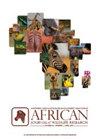南非野猪(Sus scrofa)潜在气候适宜性分布模型
IF 1
4区 环境科学与生态学
Q2 Agricultural and Biological Sciences
引用次数: 0
摘要
欧洲野猪(Sus scrofa)是世界上许多地方的入侵动物。我们利用生物气候变量和最大熵模型确定了南非野猪的潜在适宜栖息地,然后将其与该国目前的物种分布记录联系起来,从而评估了野猪入侵传播的潜力。我们发现野猪有很大的潜力扩大其在南非的入侵分布范围。最适宜的生境是有沿海边界的省份,即西开普省、东开普省和夸祖鲁-纳塔尔省。此外,通过在线问卷调查,我们发现,参与者中只有26.9%的人知道野猪的流行,29.5%的人知道野猪的冲突,29.6%的人知道野猪的狩猎地点;然而,大多数人(62.9%)知道国家外来和入侵物种名单上的物种。此外,我们还记录了夸祖鲁-纳塔尔省的流行地点和狩猎地点。根据《国家环境管理:生物多样性法》的规定,必须严格监测和控制野猪在南非的流行,以防止其蔓延并对生物多样性和农业部门产生负面影响,这在其他地方很明显。本文章由计算机程序翻译,如有差异,请以英文原文为准。
Potential Climatic Suitability Distribution Model for Wild Boar (Sus scrofa) in South Africa
European wild boar (Sus scrofa) are invasive in many parts of the world. We assessed the potential for invasive spread by the wild boar in South Africa by determining potentially suitable habitats using bioclimatic variables and the maximum entropy model, which we then related to the present distribution records of the species in the country. We found that the wild boar has great potential to extend its invasive distribution range in South Africa. The most suitable habitats were in provinces with coastal boundaries, namely the Western Cape, Eastern Cape and KwaZulu-Natal provinces. Additionally, through an online questionnaire, we found out that of the participants, only 26.9% knew of the prevalence of wild boar, 29.5% about human–wild boar conflict, and 29.6% knew of hunting sites for the species; however, the majority (62.9%) knew of the species on the National Alien and Invasive Species List. Moreover, we also recorded localities of prevalence and hunting sites within KwaZulu-Natal province. Wild boar's prevalence in South Africa must be strictly monitored and controlled as stipulated by the National Environmental Management: Biodiversity Act regulations to prevent its spread and negative impacts on biodiversity and the agriculture sector, as evident elsewhere.
求助全文
通过发布文献求助,成功后即可免费获取论文全文。
去求助
来源期刊

African Journal of Wildlife Research
Multiple-
自引率
0.00%
发文量
14
期刊介绍:
The African Journal of Wildlife Research is an ISI ranked, leading peer reviewed scientific publication in wildlife research in Africa, Arabia and Madagascar, with a broad base covering scientific, applied, managerial, methodological and sociological issues related to wildlife research. The journal publishes original full-length scientific papers, short communications, book reviews as well as reviews on science-based research invited by the editor-in-chief. This research journal and has been published annually since 1971.
Until 2014 (Volume 44) the journal was known as the South African Journal of Wildlife Research and from 2015 (volume 45) the name changed to African Journal of Wildlife Research. The journal reaches a wide readership, including both local and foreign wildlife managers, academics and wildlife owners, and libraries local and abroad. It is an important reference for anyone interested in the management and sustainable utilisation of natural resources.
 求助内容:
求助内容: 应助结果提醒方式:
应助结果提醒方式:


